C Programming if, if..else and Nested if...else Statement
The if, if...else and nested if...else statement are used to make one-time decisions in C Programming, that is, to execute some code/s and ignore some code/s depending upon the test expression.
C if Statement
if (test expression) {
statement/s to be executed if test expression is true;
}
The
if statement checks whether the text expression inside parenthesis ( ) is true or not. If the test expression is true, statement/s inside the body of if statement is executed but if test is false, statement/s inside body of if is ignored.Flowchart of if statement
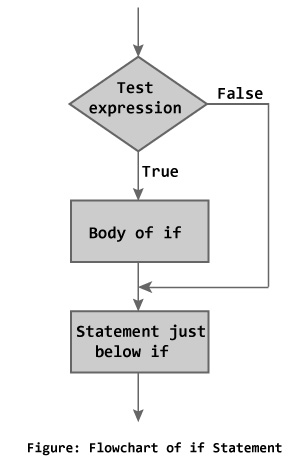
Example 1: C if statement
Write a C program to print the number entered by user only if the number entered is negative.
#include <stdio.h>
int main(){
int num;
printf("Enter a number to check.\n");
scanf("%d",&num);
if(num<0) { /* checking whether number is less than 0 or not. */
printf("Number = %d\n",num);
}
/*If test condition is true, statement above will be executed, otherwise it will not be executed */
printf("The if statement in C programming is easy.");
return 0;
}
Output 1
Enter a number to check. -2 Number = -2 The if statement in C programming is easy.
When user enters -2 then, the test expression
(num<0) becomes true. Hence, Number = -2 is displayed in the screen.
Output 2
Enter a number to check. 5 The if statement in C programming is easy.
When the user enters 5 then, the test expression
(num<0) becomes false. So, the statement/s inside body of if is skipped and only the statement below it is executed.C if...else statement
The
if...else statement is used if the programmer wants to execute some statement/s when the test expression is true and execute some other statement/s if the test expression is false.Syntax of if...else
if (test expression) {
statements to be executed if test expression is true;
}
else {
statements to be executed if test expression is false;
}
Flowchart of if...else statement
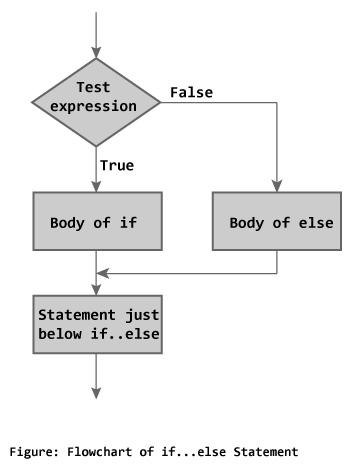
Example 2: C if...else statement
Write a C program to check whether a number entered by user is even or odd
#include <stdio.h>
int main(){
int num;
printf("Enter a number you want to check.\n");
scanf("%d",&num);
if((num%2)==0) //checking whether remainder is 0 or not.
printf("%d is even.",num);
else
printf("%d is odd.",num);
return 0;
}
Output 1
Enter a number you want to check. 25 25 is odd.
Output 2
Enter a number you want to check. 2 2 is even.
Nested if...else statement (if...elseif....else Statement)
The nested
if...else statement is used when program requires more than one test expression.Syntax of nested if...else statement.
if (test expression1){
statement/s to be executed if test expression1 is true;
}
else if(test expression2) {
statement/s to be executed if test expression1 is false and 2 is true;
}
else if (test expression 3) {
statement/s to be executed if text expression1 and 2 are false and 3 is true;
}
.
.
.
else {
statements to be executed if all test expressions are false;
}
How nested if...else works?
The nested
if...else statement has more than one test expression. If the first test expression is true, it executes the code inside the braces{ } just below it. But if the first test expression is false, it checks the second test expression. If the second test expression is true, it executes the statement/s inside the braces{ } just below it. This process continues. If all the test expression are false, code/s inside else is executed and the control of program jumps below the nested if...else
The ANSI standard specifies that 15 levels of nesting may be continued.
Example 3: C nested if else statement
Write a C program to relate two integers entered by user using = or > or < sign.
#include <stdio.h>
int main(){
int numb1, numb2;
printf("Enter two integers to check\n");
scanf("%d %d",&numb1,&numb2);
if(numb1==numb2) //checking whether two integers are equal.
printf("Result: %d = %d",numb1,numb2);
else
if(numb1>numb2) //checking whether numb1 is greater than numb2.
printf("Result: %d > %d",numb1,numb2);
else
printf("Result: %d > %d",numb2,numb1);
return 0;
}
Output 1
Enter two integers to check. 5 3 Result: 5 > 3
Output 2
Enter two integers to check. -4 -4 Result: -4 = -4
C Programming for Loop
Loops cause program to execute the certain block of code repeatedly until test condition is false. Loops are used in performing repetitive task in programming. Consider these scenarios:
- You want to execute some code/s 100 times.
- You want to execute some code/s certain number of times depending upon input from user.
These types of task can be solved in programming using loops.
There are 3 types of loops in C programming:
- for loop
- while loop
- do...while loop
for Loop Syntax
for(initialization statement; test expression; update statement) {
code/s to be executed;
}
How for loop works in C programming?
The initialization statement is executed only once at the beginning of the for loop. Then the test expression is checked by the program. If the test expression is false, for loop is terminated. But if test expression is true then the code/s inside body of
for loop is executed and then update expression is updated. This process repeats until test expression is false.
This flowchart describes the working of for loop in C programming.
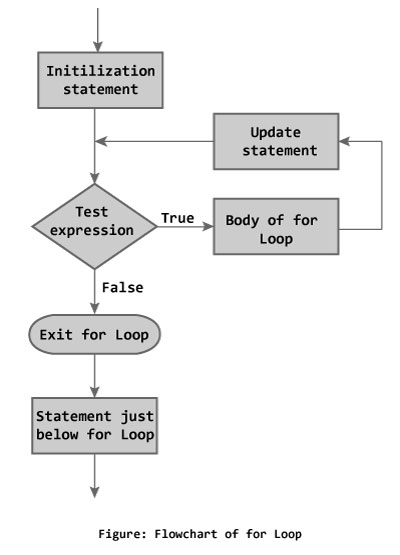
for loop example
Write a program to find the sum of first n natural numbers where n is entered by user. Note: 1,2,3... are called natural numbers.
#include <stdio.h>
int main(){
int n, count, sum=0;
printf("Enter the value of n.\n");
scanf("%d",&n);
for(count=1;count<=n;++count) //for loop terminates if count>n
{
sum+=count; /* this statement is equivalent to sum=sum+count */
}
printf("Sum=%d",sum);
return 0;
}
Output
Enter the value of n. 19 Sum=190
In this program, the user is asked to enter the value of n. Suppose you entered 19 then, count is initialized to 1 at first. Then, the test expression in the for loop,i.e.,
(count<= n) becomes true. So, the code in the body of for loop is executed which makes sum to 1. Then, the expression ++count is executed and again the test expression is checked, which becomes true. Again, the body of for loop is executed which makes sum to 3 and this process continues. When count is 20, the test condition becomes false and the for loop is terminated.C programming while and do...while Loop
There are two statements built in C programming,
break; and continue; to alter the normal flow of a program. Loops perform a set of repetitive task until text expression becomes false but it is sometimes desirable to skip some statement/s inside loop or terminate the loop immediately without checking the test expression. In such cases, break and continue statements are used. The break;statement is also used in switch statement to exit switch statement.break Statement
In C programming, break is used in terminating the loop immediately after it is encountered. The break statement is used with conditional if statement.
Syntax of break statement
break;
The break statement can be used in terminating all three loops for, while and do...while loops.
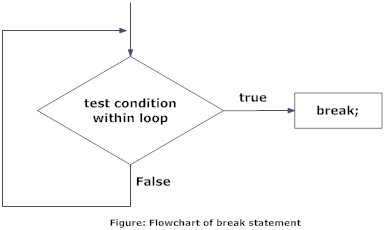
The figure below explains the working of break statement in all three type of loops.
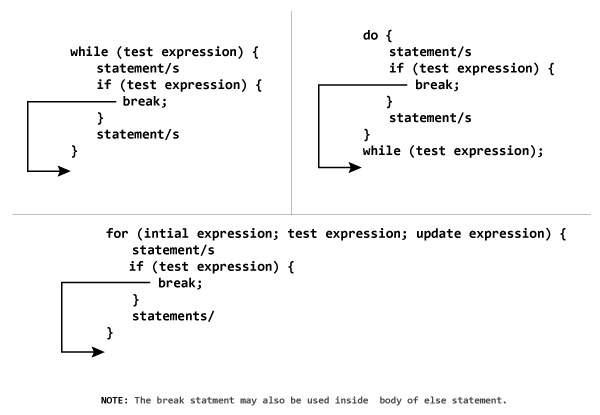
Example of break statement
Write a C program to find average of maximum of n positive numbers entered by user. But, if the input is negative, display the average(excluding the average of negative input) and end the program.
/* C program to demonstrate the working of break statement by terminating a loop, if user inputs negative number*/
# include <stdio.h>
int main(){
float num,average,sum;
int i,n;
printf("Maximum no. of inputs\n");
scanf("%d",&n);
for(i=1;i<=n;++i){
printf("Enter n%d: ",i);
scanf("%f",&num);
if(num<0.0)
break; //for loop breaks if num<0.0
sum=sum+num;
}
average=sum/(i-1);
printf("Average=%.2f",average);
return 0;
}
Output
Maximum no. of inputs 4 Enter n1: 1.5 Enter n2: 12.5 Enter n3: 7.2 Enter n4: -1 Average=7.07
In this program, when the user inputs number less than zero, the loop is terminated using break statement with executing the statement below it i.e., without executing
sum=sum+num.
In C, break statements are also used in switch...case statement. You will study it in C switch...case statement chapter.
continue Statement
It is sometimes desirable to skip some statements inside the loop. In such cases, continue statements are used.
Syntax of continue Statement
continue;
Just like break, continue is also used with conditional if statement.
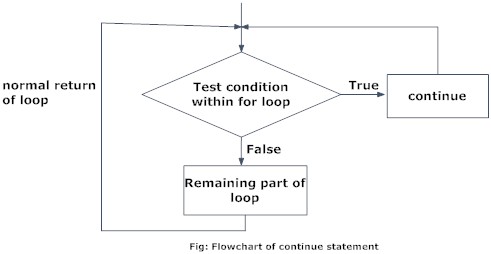
For better understanding of how continue statements works in C programming. Analyze the figure below which bypasses some code/s inside loops using continue statement.
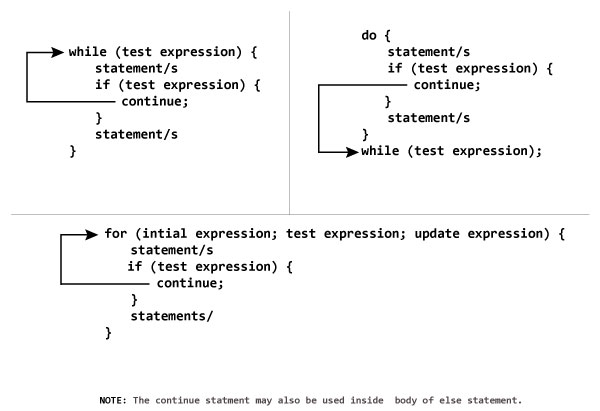
Example of continue statement
Write a C program to find the product of 4 integers entered by a user. If user enters 0 skip it.
//program to demonstrate the working of continue statement in C programming
# include <stdio.h>
int main(){
int i,num,product;
for(i=1,product=1;i<=4;++i){
printf("Enter num%d:",i);
scanf("%d",&num);
if(num==0)
continue; / *In this program, when num equals to zero, it skips the statement product*=num and continue the loop. */
product*=num;
}
printf("product=%d",product);
return 0;
}
Output
Enter num1:3 Enter num2:0 Enter num3:-5 Enter num4:2 product=-30
C Programming switch Statement
Decision making are needed when, the program encounters the situation to choose a particular statement among many statements. If a programmer has to choose one block of statement among many alternatives, nested if...else can be used but, this makes programming logic complex. This type of problem can be handled in C programming using
switch statement.Syntax of switch...case
switch (n) {
case constant1:
code/s to be executed if n equals to constant1;
break;
case constant2:
code/s to be executed if n equals to constant2;
break;
.
.
.
default:
code/s to be executed if n doesn't match to any cases;
}
The value of n is either an integer or a character in above syntax. If the value of n matches constant in
case, the relevant codes are executed and control moves out of the switch statement. If the ndoesn't matches any of the constant in case, then the default codes are executed and control moves out of switch statement.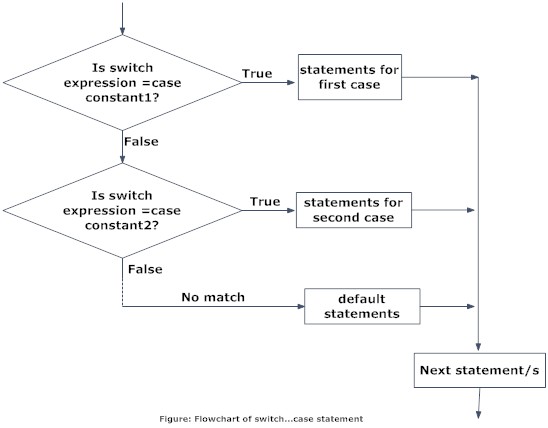
Example of switch...case statement
Write a program that asks user an arithmetic operator('+','-','*' or '/') and two operands and perform the corresponding calculation on the operands.
/* C program to demonstrate the working of switch...case statement */
/* C Program to create a simple calculator for addition, subtraction,
multiplication and division */
# include <stdio.h>
int main() {
char o;
float num1,num2;
printf("Select an operator either + or - or * or / \n");
scanf("%c",&o);
printf("Enter two operands: ");
scanf("%f%f",&num1,&num2);
switch(o) {
case '+':
printf("%.1f + %.1f = %.1f",num1, num2, num1+num2);
break;
case '-':
printf("%.1f - %.1f = %.1f",num1, num2, num1-num2);
break;
case '*':
printf("%.1f * %.1f = %.1f",num1, num2, num1*num2);
break;
case '/':
printf("%.1f / %.1f = %.1f",num1, num2, num1/num2);
break;
default:
/* If operator is other than +, -, * or /, error message is shown */
printf("Error! operator is not correct");
break;
}
return 0;
}
Output
Enter operator either + or - or * or / * Enter two operands: 2.3 4.5 2.3 * 4.5 = 10.3
The
break statement at the end of each case cause switch statement to exit. If break statement is not used, all statements below that case statement are also executed.C Programming goto Statement
In C programming, goto statement is used for altering the normal sequence of program execution by transferring control to some other part of the program.
Syntax of goto statement
goto label; ............. ............. ............. label: statement;
In this syntax, label is an identifier. When, the control of program reaches to goto statement, the control of the program will jump to the
label: and executes the code below it.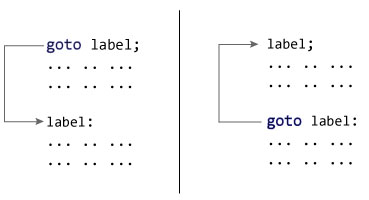
Example of goto statement
/* C program to demonstrate the working of goto statement. */
/* This program calculates the average of numbers entered by user. */
/* If user enters negative number, it ignores that number and
calculates the average of number entered before it.*/
# include <stdio.h>
int main(){
float num,average,sum;
int i,n;
printf("Maximum no. of inputs: ");
scanf("%d",&n);
for(i=1;i<=n;++i){
printf("Enter n%d: ",i);
scanf("%f",&num);
if(num<0.0)
goto jump; /* control of the program moves to label jump */
sum=sum+num;
}
jump:
average=sum/(i-1);
printf("Average: %.2f",average);
return 0;
}
Output
Maximum no. of inputs: 4 Enter n1: 1.5 Enter n2: 12.5 Enter n3: 7.2 Enter n4: -1 Average: 7.07
Though goto statement is included in ANSI standard of C, use of goto statement should be reduced as much as possible in a program.
Reasons to avoid goto statement
Though, using goto statement give power to jump to any part of program, using goto statement makes the logic of the program complex and tangled. In modern programming, goto statement is considered a harmful construct and a bad programming practice.
The goto statement can be replaced in most of C program with the use of break and continue statements. In fact, any program in C programming can be perfectly written without the use of goto statement. All programmer should try to avoid goto statement as possible as they can.
No comments:
Post a Comment